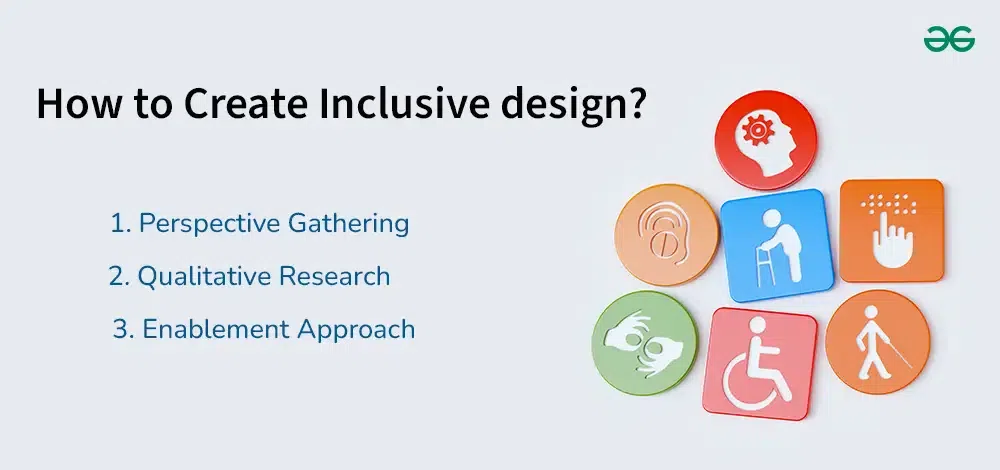How to Create Inclusive design?
Last Updated :
16 May, 2024
Inclusivity is not just about bringing more audiences, it is about embracing diversity and making room for people of all backgrounds, regardless of the abilities they possess. Inclusive design not only invites more participation but also celebrates the richness that comes with diversity. Inclusive design is a series of design processes that focuses on understanding people from diverse backgrounds and enabling them to be able to use our products or services. It is a very important step in achieving accessibility in our design and reaching out to more audiences. In this article, we will discuss what Inclusive design is and how to create Inclusive designs.

How to Create Inclusive design?
What is Inclusive Design?
Inclusive design is a creative process that emphasizes understanding people from various backgrounds, cultures, and abilities, and empowering them to seamlessly interact with the products or services we create. It is a proactive approach where we acknowledge the inherent diversity in our society and we try to eliminate barriers that may hinder equal access and participation. This also includes accessibility, but it covers a more broad spectrum of differences, these differences include age, culture, economic status, education, geographic location, and language, among many others. Inclusivity includes accessibility but it is not the same as Accessibility, accessibility is a goal, a destination. Inclusive design is how we get to that destination.
An example of Inclusive design can be solving the problem statement that many people may fail to register their last names on websites or applications. People may face issues like character limits, etc. One way an inclusive design can solve this problem is by allowing people to report this problem and ask for assistance.
The Guiding Principles of Inclusive Design
The three important principles of Inclusive design are:
1. Embracing Diversity:
Inclusive design embraces the rich tapestry of human diversity, recognizing that no two individuals are alike. It encourages us to understand and cater to the unique needs, preferences, and experiences of diverse user groups.
2. Iterative and Collaborative Approach:
Inclusive design is an iterative process that thrives on collaboration with users, stakeholders, and subject matter experts. It involves continuous feedback loops, ensuring that designs evolve and adapt to meet the ever-changing needs of diverse audiences.
3. Flexibility and Adaptability:
Inclusive design acknowledges that a one-size-fits-all approach is often limiting and restrictive. It advocates for flexible and adaptable solutions that can be tailored to individual preferences, abilities, and contexts.
How to Create Inclusive Designs?
Inclusivity in design is difficult to put into a step by step approach since there is no one size fits all in Inclusive design, it depends on what product you are building and what the market conditions are. Enhancing the inclusively of the product may vary from product to product but these three points are useful for almost all products:
1. Perspective Gathering:
Engage with underrepresented user groups to gain invaluable insights into the societal pressures, systemic issues, or personal circumstances that may hinder their access or participation. By identifying the root causes – whether social pressures, familial concerns, or systemic barriers – we can begin to dismantle these obstacles and create more inclusive experiences.
2. Qualitative Research:
Since we are designing for a world that speaks many languages and comes from many different backgrounds. Researching for these demographics is essential. Use qualitative research methods to gain a deeper understanding of your target audience. Start by identifying who might be excluded or have difficulty accessing your services. This helps in building empathy and tailoring designs to meet diverse user needs.
3. Enablement Approach:
Enablement over One-Size-Fits-All: Inclusive design is about enablement, not forcing a single solution upon diverse users. Enable flexibility in your design by creating multiple pathways for engagement and contribution, accommodating diverse backgrounds, abilities, and preferences. Meeting the needs of diverse users may require designing multiple solutions, each tailored to specific context.
By prioritizing perspective gathering, qualitative research, and an enablement-focused approach, designers can navigate the complexities of inclusive design and craft experiences that actually resonate with their audiences, providing a sense of belonging and accessibility for all.
Best Practices – Inclusivity
Other than the points we mentioned in the above section, make sure to follow these points to ensure inclusivity in your design:
1. Research:
People have different limitations on what they can easily see, understand and feel comfortable with. Research about such possible pain points of your customers and come up with solutions in your design.
2. Accessible Design:
Makes sure that you design is accessible. When we say that a design is accessible we mean that it can be used by people who have hearing, visual, motor or cognitive impairments.
3. Give People Choices:
When designing interfaces, allow people to describe themselves in their own terms. This can be done by for example, turning a one choice only radio button into a “select all that apply” checkbox.
4. Constant Feedback:
As designers, we shouldn’t assume that we know everything there is to know about people, we should invite them to help us learn. Take regular feedback about your website or application and iterate accordingly.
Conclusion
In this article, we discussed what Inclusive designs are? Along with that we discussed how to create Inclusive designs. Inclusive design is a creative process that emphasizes understanding people from various backgrounds, cultures, and abilities, and empowering them to seamlessly interact with the products or services we create. It is a proactive approach where we acknowledge the inherent diversity in our society and we try to eliminate barriers that may hinder equal access and participation. Make sure to follow the points mentioned in the article we create professional inclusive designs.
Share your thoughts in the comments
Please Login to comment...